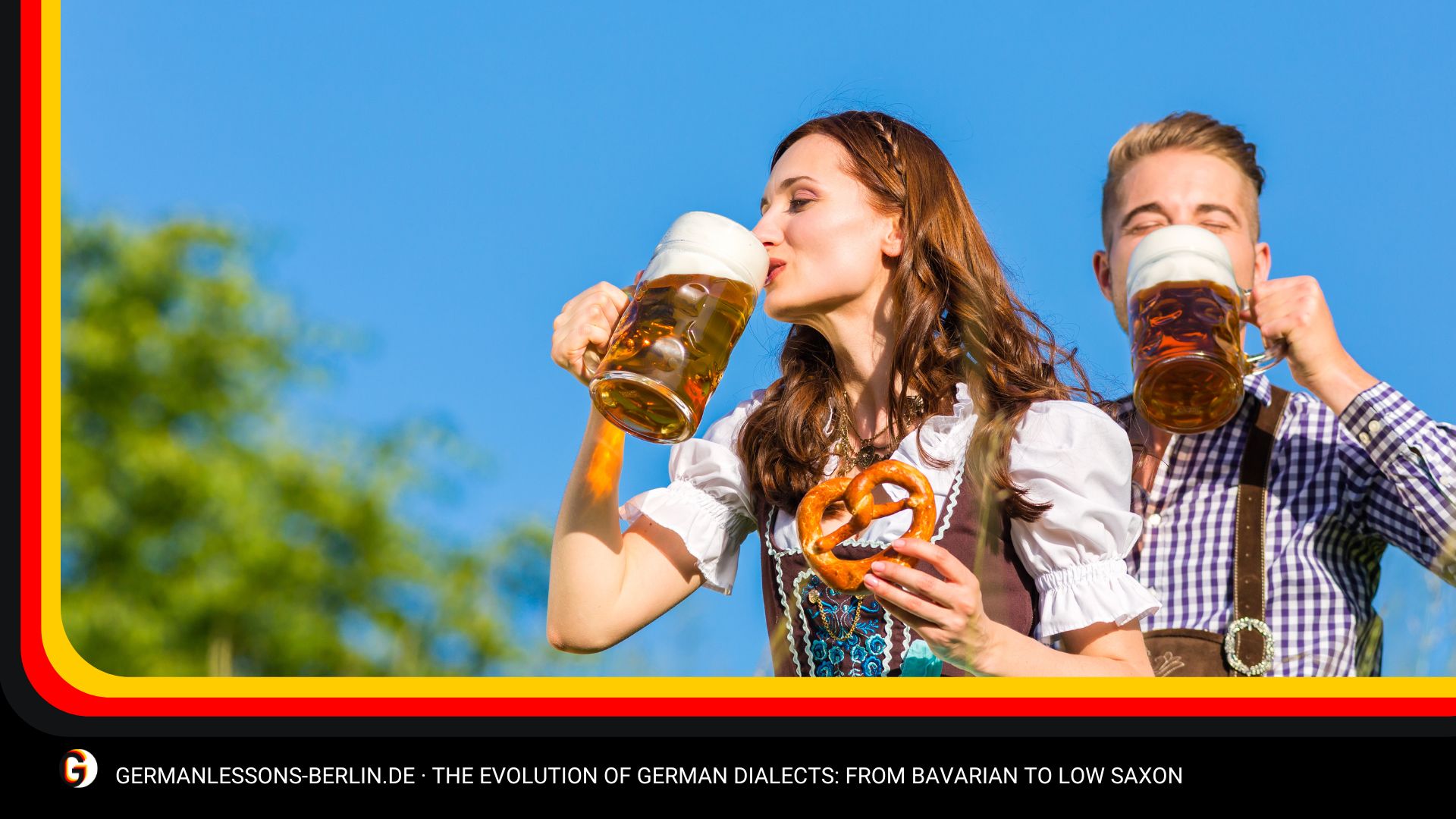You’ve always been fascinated by languages, haven’t you? Let’s delve into the intriguing world of German dialects. From the melodious tones of Bavarian to the robust sounds of Low Saxon, you’ll explore their evolution, unique characteristics, and cultural impacts. You’ll also compare these dialects, discovering their similarities and differences. Ready to embark on this linguistic journey? Let’s uncover the future of these dialects in modern usage and their preservation. It’s time you understood the richness of German dialects.
Key Takeaways
- German dialects offer insights into historical events and cultural shifts.
- The spread of Christianity and the influence of the Hanseatic League impacted the development of German dialects.
- Political divisions, such as the separation of East and West Germany, affected linguistic variations.
- The preservation and modern usage of German dialects are crucial for their continued thriving.
The Historical Background of German Dialects
You’d be fascinated to know that someone’s German dialect can offer a peek into the historical events and cultural shifts that have shaped Germany over the centuries. Think about how the spread of Christianity influenced the Old High German period, or how the Hanseatic League’s trade dominance impacted the development of Low German dialects. Consider the impact of political divisions, such as the separation of East and West Germany, on linguistic variations. Even today, regional dialects reveal much about Germany’s past. So, next time you’re chatting with a German speaker, pay attention to their dialect. It’s not just an accent, it’s a window into the rich tapestry of German history.
The Unique Characteristics of Bavarian Dialect
While you’re exploring the Bavarian dialect, you’ll notice it’s not just different in pronunciation, it also carries unique grammar and vocabulary that sets it apart from other German dialects. Words like “Feierabend” (end of work) and “Brotzeit” (snack time) are distinctively Bavarian.
To help you understand, here’s a comparison table:
| Standard German | Bavarian Dialect | English Translation |
|---|---|---|
| Ja | Jo | Yes |
| Nein | Na | No |
| Danke | Merci | Thank you |
The dialect also has a softer intonation that’s easier on the ears. So, when you’re in Bavaria, don’t be surprised if you find the locals’ speech a little different. It’s all part of the rich tapestry that makes up the German language.
The Influence of Politics and Society on Bavarian Dialect
In your exploration of the Bavarian dialect, you can’t ignore the profound impact politics and society have had on its evolution. It’s politics that have shaped the dialect’s distinctiveness. The region’s historical separation from the rest of Germany led to a unique linguistic development. This isolation allowed the Bavarian dialect to preserve many Old High German features.
Society also plays a vital role. The strong regional identity of Bavarians manifests in their speech. They’ve held onto their dialect as a symbol of cultural pride, despite the homogenizing influence of standard German. You can see this especially in rural areas, where locals still proudly use traditional Bavarian phrases.
Overview of the Low Saxon Dialect
Now, you’re stepping into the realm of Low Saxon, a dialect that’s as rich and diverse as the region it hails from. It’s a language with a distinct flavor, deeply rooted in the histories and cultures of northern Germany and the Netherlands. Here are four things you should know about Low Saxon:
- Geographical Distribution: It’s mainly spoken in the Lower Saxony region of Germany and parts of the Netherlands.
- Linguistic Features: It’s marked by a flat intonation, unique word formations, and a distinct pronunciation.
- Historical Significance: It was the most widely spoken language during the Hanseatic League era.
- Modern Use: Despite being less prevalent today, it’s still cherished as part of regional identity.
That’s your brief overview of Low Saxon – a dialect reflecting a rich tapestry of historical, cultural, and regional influences.
Cultural Impact on the Development of Low Saxon
You’ll discover that a multitude of factors, including but not limited to two significant cultural shifts, have shaped and molded the development of the Low Saxon dialect. The first shift, the Christianization of Saxony, introduced Latin and Old High German influences. The second, the Industrial Revolution, brought standard German influx. Both events significantly changed Low Saxon’s vocabulary, syntax, and phonetics.
Below is a concise summary of these influences:
| Cultural Shift | Influences | Changes in Low Saxon |
|---|---|---|
| Christianization | Latin, Old High German | Vocabulary, Syntax |
| Industrial Revolution | Standard German | Vocabulary, Syntax, Phonetics |
Understanding these impacts will help you appreciate the richness and complexity of the Low Saxon dialect, a vital part of Germany’s linguistic heritage.
Comparing Bavarian and Low Saxon: Similarities and Differences
Diving into the comparison between Bavarian and Low Saxon, you’ll find both striking similarities and notable differences in these two intriguing German dialects.
- Both dialects have unique pronunciation patterns that set them apart from standard German.
- Bavarian dialect has more variations, due to the region’s geographical diversity, while Low Saxon is more consistent.
- In terms of vocabulary, both dialects have words that are not found in other German dialects.
- However, the syntax in Bavarian tends to be more complex than in Low Saxon.
Understanding these elements can certainly enrich your appreciation of the vibrant tapestry that is German linguistics. Now, let’s shift our focus to the future of German dialects: preservation and modern usage.
The Future of German Dialects: Preservation and Modern Usage
In considering the future of German dialects, you’re faced with the intriguing challenge of both preserving their historic richness and adapting them for modern usage. It’s a delicate balance, but achievable. You may wonder, how can we keep these dialects alive? Firstly, it’s about education and exposure. More German schools are incorporating dialect study into their curriculum, fostering an appreciation for these unique linguistic gems. Secondly, you’ll find these dialects shining in media, from TV shows to music. This promotes their modern relevance. Lastly, communities play a crucial role, as they continue to use these dialects daily, ensuring their survival. Yes, the future of German dialects is a complex topic, but with preservation efforts and modern usage, they can continue to thrive.
Frequently Asked Questions
How Is the German Language Taught in Schools Today, Particularly in Regions Where Dialects Are Widely Spoken?
In schools today, you’re taught standard German, even in regions where dialects are prevalent. It’s a nationwide policy to ensure everyone’s learning uniform language skills. However, you’d still hear dialects used informally by locals. In some schools, they even offer dialect classes, but that’s typically an add-on, not a substitute for standard German. So, while dialects add richness to the cultural fabric, standard German is what you’ll primarily learn in school.
What Are Some Popular German Idioms That Originated From These Dialects?
You’re asking about popular German idioms that originated from dialects. Well, there’s a lot! For instance, “Das ist nicht mein Bier” which literally translates to “That’s not my beer” is from Bavarian dialect, meaning “That’s not my problem”. And from Low Saxon, “Ik versteih nur Bahnhof”, meaning “I only understand train station,” is used when you’re completely confused. There’s a rich variety of idioms that reflect the unique character of each dialect.
Are There Any Popular Musicians or Artists Who Use These Dialects in Their Work?
Absolutely, there are popular musicians who incorporate these dialects into their work. Artists like Heino, a folk singer, often use Low Saxon dialect in their songs. Similarly, Die Toten Hosen, a punk band, have songs in the Bavarian dialect. They’re keeping these dialects alive and kicking in the modern music scene, showing the cultural richness and diversity of the German-speaking world. It’s quite fascinating, don’t you think?
What Impact Has Immigration Had on These German Dialects?
Immigration’s impacted German dialects significantly. As you interact with people from different cultures, you’ll notice new words and phrases incorporated into the language. This fusion enhances dialects, making them more vibrant and dynamic. It’s not just about vocabulary, but also pronunciation and grammar. So, you see, immigration doesn’t dilute the dialects, it enriches them, creating a fascinating linguistic tapestry reflective of Germany’s multicultural society.
How Have German Dialects Influenced Neighbouring Languages and Dialects?
You might be surprised to know German dialects have significantly influenced neighboring languages. For example, Yiddish borrows heavily from German. In the Netherlands, the Dutch language’s syntax and vocabulary show clear German influence. Even English, a Germanic language, retains German elements. So, it’s not just about how German dialects evolve, but also how they shape other languages.
Conclusion
So, you’ve journeyed through the evolution of German dialects, from Bavarian to Low Saxon. You’ve seen how history, politics, and culture shape language, and how these dialects differ and align. The future? It’s a mix of preservation and modern use. But remember, language is alive, always evolving. So, keep an ear out for the next chapter in the fascinating tale of German dialects. It’s a story that’s far from over.








